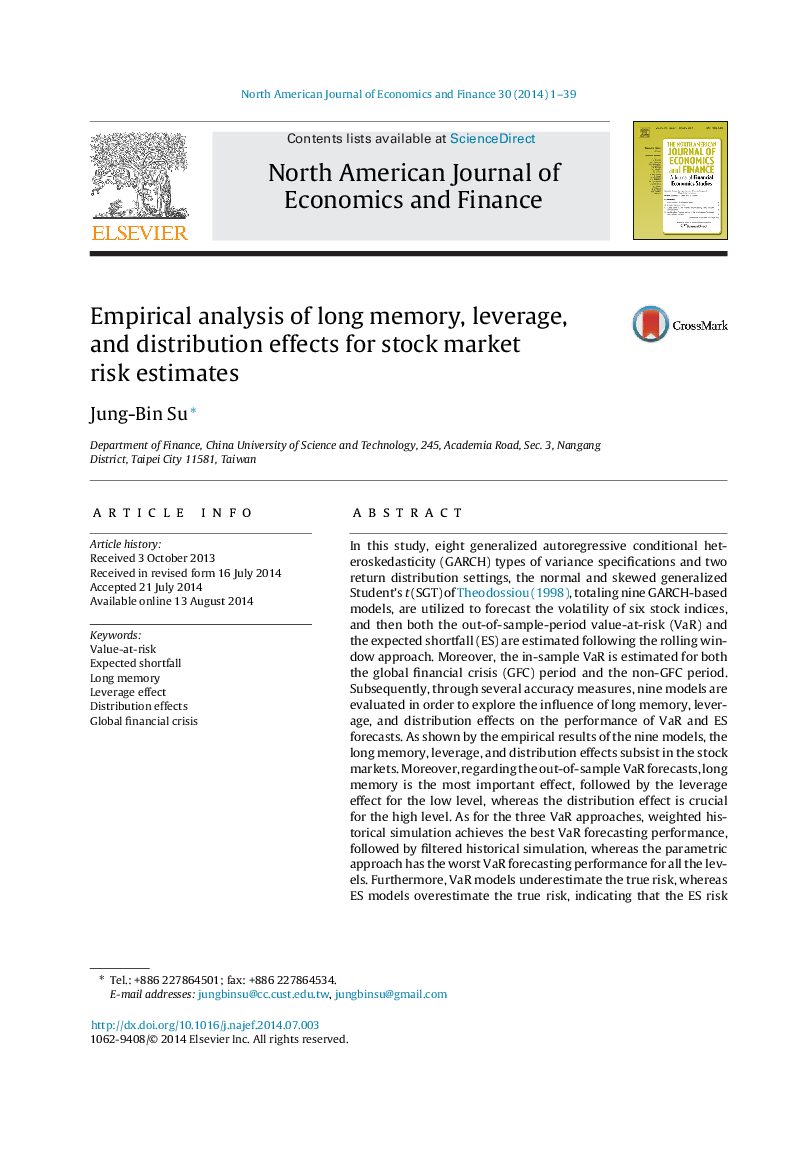| کد مقاله | کد نشریه | سال انتشار | مقاله انگلیسی | نسخه تمام متن |
|---|---|---|---|---|
| 973143 | 1479784 | 2014 | 39 صفحه PDF | دانلود رایگان |
• For out-of-sample VaR forecasts distribution effect is crucial for high level.
• The WHS (the parametric approach) has the best (worst) VaR forecasting performance.
• VaR (ES) models underrate (overrate) the risk and thus ES is more cautious than VaR.
• Long memory (long memory and leverage effect) is major for ES (VaR) estimate.
• Regarding in-sample VaR forecasts distribution effect is crucial for GFC period.
In this study, eight generalized autoregressive conditional heteroskedasticity (GARCH) types of variance specifications and two return distribution settings, the normal and skewed generalized Student's t (SGT) of Theodossiou (1998), totaling nine GARCH-based models, are utilized to forecast the volatility of six stock indices, and then both the out-of-sample-period value-at-risk (VaR) and the expected shortfall (ES) are estimated following the rolling window approach. Moreover, the in-sample VaR is estimated for both the global financial crisis (GFC) period and the non-GFC period. Subsequently, through several accuracy measures, nine models are evaluated in order to explore the influence of long memory, leverage, and distribution effects on the performance of VaR and ES forecasts. As shown by the empirical results of the nine models, the long memory, leverage, and distribution effects subsist in the stock markets. Moreover, regarding the out-of-sample VaR forecasts, long memory is the most important effect, followed by the leverage effect for the low level, whereas the distribution effect is crucial for the high level. As for the three VaR approaches, weighted historical simulation achieves the best VaR forecasting performance, followed by filtered historical simulation, whereas the parametric approach has the worst VaR forecasting performance for all the levels. Furthermore, VaR models underestimate the true risk, whereas ES models overestimate the true risk, indicating that the ES risk measure is more conservative than the VaR risk measure. Additionally, based on back-testing, the VaR provides a better risk forecast than the ES since the ES highly overestimates the true risk. Notably, long memory is important for the ES estimate, whereas both the long memory and the leverage effect are crucial for the VaR estimate. Finally, via in-sample VaR forecasts in regard to the low level, it is found that long memory is important for the non-GFC period, whereas the distribution effect is crucial for the GFC period. On the other hand, with regard to the high level, the distribution effect is crucial for both the non-GFC and the GFC period. These results seem to be consistent with those found in the out-of-sample VaR forecasts. In accordance with these results, several important policy implications are proposed in this study.
Journal: The North American Journal of Economics and Finance - Volume 30, November 2014, Pages 1–39
